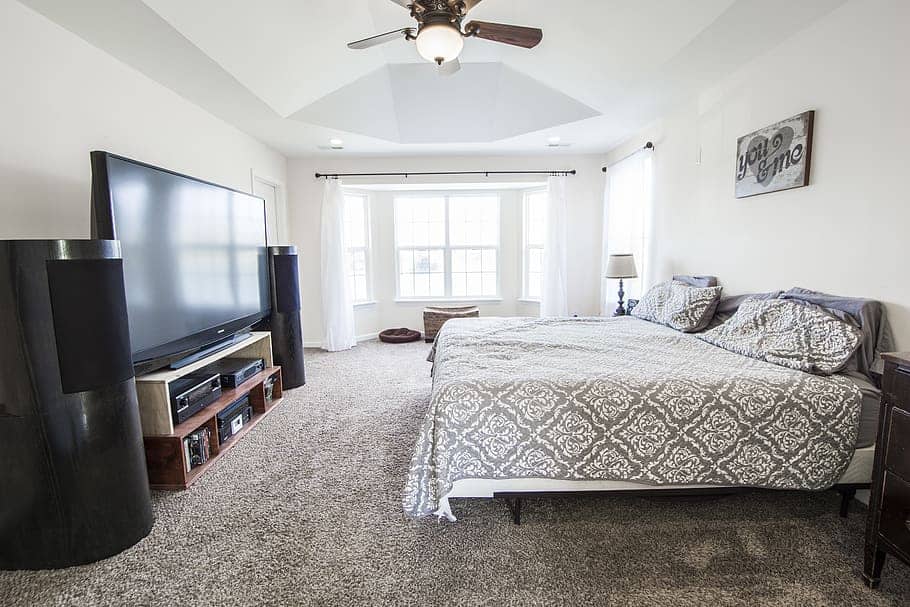Couples counseling sometimes overlaps with seemingly unimportant decisions about where to store the cutlery, which drawer to use, whether to keep the toaster in the cupboard when it’s not in use, and so on. Intimate relationships experience significant ruptures over these mundane things. Related to this, difficulty in the bedroom can be a catastrophe for relationships. The primary function of the bedroom, I content here in this post, is sleep and sex (or intimacy). With that said, I will answer the question:
What are five things someone should never have in their bedroom?
1) Television / screens — cell phones, laptops, the nice 60″ flatscreen on the wall
2) Workout equipment — weights, treadmill, elliptical, stationary bike
3) Coffee — and tea, any “uppers” or caffeinated beverages
4) Workstations — the home office / bedroom combo; a desk, a ‘productive’ space mixed into your sleep/sex space
5) “anything that says ‘stay awake’ to you” (pictures, artifacts, spaceholders, decor, etc)

Why are each of these a bad thing to have in this room?
TVs and screens, workout equipment, work-related items, these are all the opposite of what you want in your bedroom. Going with this assumption, bedrooms are for sleep and sex only — you want everything in your room to give your body the signal of “go to sleep” or “be intimate.” Think of walking into a gym — the music, the smells, the size and shape of the room all ‘mean’ something to your nervous system. Usually, your clothes will match the part, the energy and affect add up to a “get to work feeling.” All spaces do this, particularly over a long period of time. Religious, spiritual spaces create this kind of neural, psychological routine for us. The rituals themselves take on a life of their own as we catch them in our bodies (see: “The Body Keeps the Score”).
The mental /emotional state created by what you do have in the room should support the desired function, which in the case of a bedroom is “go to sleep!” or “be intimate.” Anything that creates an internal, mental space of “be productive,” “pay attention,” “get to work,” or otherwise distracts you from your partner / sleep should be stored elsewhere. Screens, in particular, here named on my list as “TV” are the opposite of sleep and intimacy. Who hasn’t lost hours in a great TV show, only to regret it the next day? Doing this on repeat, along with the blue lights of most screens, tell our brains to stay awake. Coupling ‘lay in bed’ and ‘stay awake’ as a regular routine trains your body to do this next time, and the time after that — lay in bed and stay awake.

What if your partner and you disagree on this?
A TV in the bedroom, an elliptical, weight set, or workstation may actually be something they like or enjoy. The conflict is ultimately about the goals, function of that space. As a couples therapist, I recommend against any mixing of your living spaces in a way that makes them ineffective for you. Work space should be for work, sleep space should be for sleep. If your partner is put off by what you have in your room (or they are put off by what’s in your room), then hopefully there’s some room to connect, state your needs and values, and talk through “What is the function of this space / room for us?” and how can we accommodate those goals — you may have different goals for that space, and different ideas about how to achieve that goal. As a therapist, I recommend the bedroom for sleep and sex only. You want to walk into that room and have every part of your body know what’s going to happen. A visual signal (e.g. the TV is on) that contradicts plan you have for yourself (e.g. go to bed) is going to create some dissonance. Most likely, you’re creating a routine of staying up later than you mean to, unsatisfying sleep, disconnect from your partner, etc.
If this is something your partner wants to keep, where should they considering storing it instead?
It depends on what your whole living situation is like. It also depends on the item. It could be a decorative object, sentimental, a religious artifact, something held in a different way at the emotional level for both you and your partner. As an example, picture a stately painting of one’s family. Or, maybe a slogan-bearing poster. It could be sports, cultural, reflective, political. Then, there’s the meaning of the object: the artwork is sentimental to your partner, and it holds a very different emotional charge for you. It could just be a big mirror. The content of the conversation with you and your partner may run through what this object means, and what its function is in the bedroom. Does a big mirror hanging on the wall help or get in the way of our comfort and intimacy in this space? Can I sleep well after walking into a room with (insert the object) in this space?
Some people live in a studio, or a space that doesn’t allow for a “home office” wholly separate from your sleeping space. There may be logistical concerns that align, or contradict, the emotional attachment to these objects. Maybe there’s just a curtain between the desk, laptop, workspace and the bedroom, or maybe there’s nothing at all. What does a couple do when transitioning, in essentially the same room, from “non-work” or “non-sleep” functions to then engaging with those things? This is especially prescient for couples with young children and babies, as co-sleeping is common, and sharing a bedroom with a crib is sometimes required. There’s “perfection,” or purity of a space’s function, and then there’s “good enough.” For a couple, this may mean, doing what you can within the given limits of your space, and emotional flexibility and adaptability. If possible, store the “non sleep thing” (like the TV screen, laptop, etc) in a way that is out of sight when it’s time to go to sleep. When it’s time to be intimate, obviously you want to turn the TV off, focus on your partner — this same concept generalizes to all the ways you use your space. Cultivate a space, and related routines, that give your body and self clear, consistent signals so that these spaces, rituals, connections are predictable, functional, effective.
To circle back to the list itself — for some couples, the blueprint or check-list of “don’t keep these items in the bedroom” may not be enough. This doesn’t have to be a troublesome resolution, as this may be an opportunity for you and your partner to talk about values, hopes, dreams for your shared space. What are your non-negotiables for the bedroom, living room, and so on? It could be a conversation about style, but as a couples counselor I would recommend having a deeper conversation about how you want your home to “feel,” function, what are you goals as a couple. It may lead to some awareness of conflict ideas about what it means to “rest,” how you de-compress at the end of a long day, how you connect and move to an emotional space of intimacy, and how you want to express these needs from day to day. What feels like “safe” to you when you walk into a room? For some people, a TV playing at 100/100 volume feels like “home,” their nervous system attunes to this sensation as goodness, rest, ‘I’m letting my guard down.’ Many couples have contra-indicated experiences of safety, rest, intimacy — this is why this can be such a deep, rewarding conversation.
As a specific note of hope: There are sometimes opportunity for how to “signal” to your partner “I want to be intimate” by how you set up your bedroom at the end of the day. Have fun with the conversation. Be playful about when you play (e.g. connect, become intimate, sleep and rest). “Play” usually means mutual trust, safety, connection. How can we play with our home, spaces, where we set our bounds on work and ‘screen time’ so that we both enjoy each other and our home?
For you who are noticing some need for deeper conversation, one helpful aspect of couples therapy is that it creates a safe space for couples to name that which is difficult to put to words. A skilled therapist can help support the skill development in order for you and your partner to connect, and create the space for you to use these skills in the room with each other. Reach out now if you have questions about developing safety, intimacy, connection with you and your partner.

